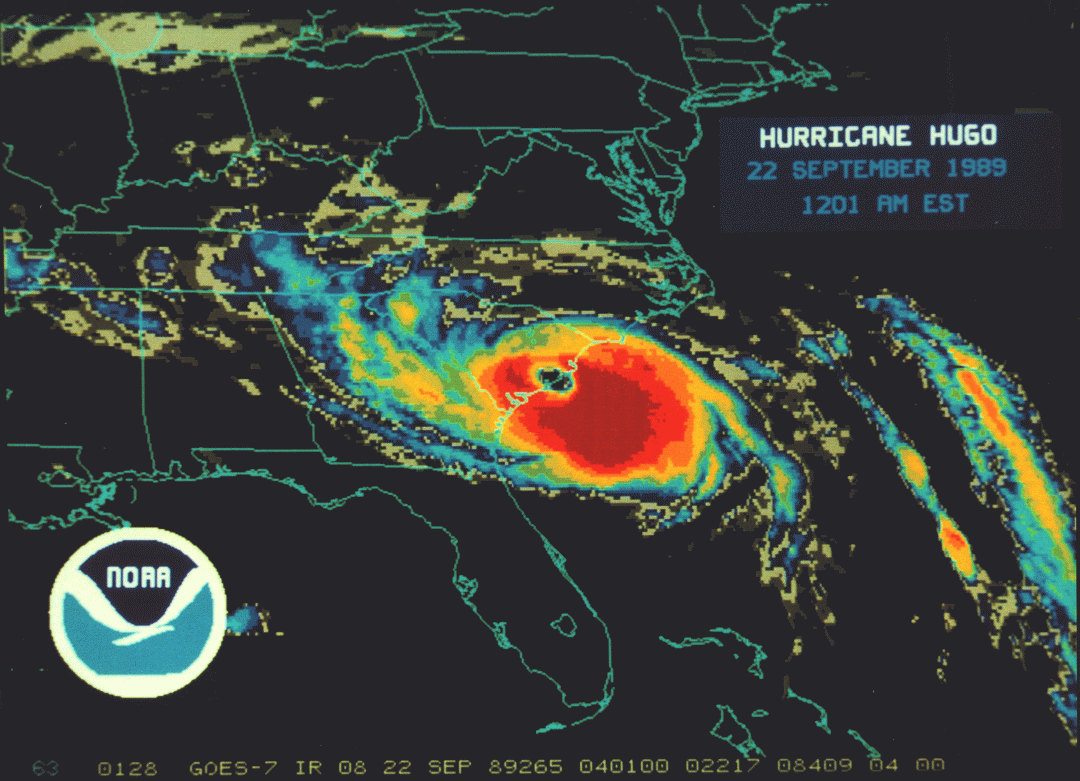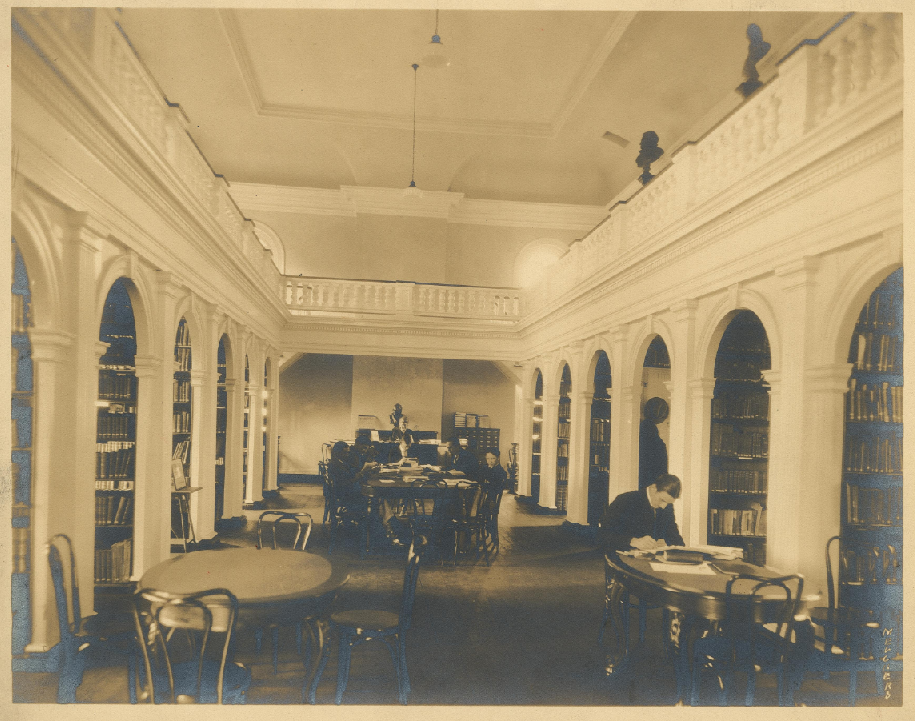I HEART COFC
September 22, 1989 continues to be a day etched into the memories of those who call the Lowcountry home. Shortly after midnight, the Category 4 storm known as Hugo made landfall destroying over 3,000 homes in South Carolina alone. Due to its devastation in the Caribbean and Eastern United States, the name was retired by NOAA and the National Hurricane Center.

Hurricane Hugo, 22 September 1989.
These storms aren’t uncommon- and luckily the College has survived much more than just hurricanes. You can add earthquakes, fire, war, and students to the list. President McConnell has shared with the campus community that safety continues to be the highest priority of the administration. The Emergency Management Team works with local, state, and federal agencies to ensure they can provide the safest outcome for our students, faculty, and staff.
It’s not every year that we get to kick-off the school year with a full solar eclipse and then a few weeks later a major storm. Regardless, of those two big events- there’s been a lot of other neat stuff happening on campus. So to keep you up to date of what’s going on around our historic campus, here’s a sneak peek into The College Today:
- CofC Student Kick-Off the Academic Year with a Solar Eclipse
- CofC Earns High Marks from the Princeton Review
- International BBC Program Coming to Cistern Yard
- Jewish Student Union Holds Kick-Off Cookout
- Alum Addresses Education Gaps in South Africa
- CofC Professor’s Book Examines American War Fiction
- English Major’s Work Published in S.C. Anthology
FROM THE PARENT LISTSERV
Sometimes our Parent Listserv can get a little hairy but there are also jewels of wisdom that come from the many family members who are willing to share their own experiences and offer advice. Many of those come from our favorite Director of Orientation, Stephanie Auwaerter. This quarter, Stephanie shares an excerpt from Helping Your First-Year College Student Succeed: A Guide for Parents. I’m sure that many of our family members can attest to the accuracy of this “Rhythm of College Life”.
Like Clockwork: The Rhythm of College Life
Certain times in the academic year tend to be universally challenging for students. Parents who understand the ups and downs of the first college year are better able to help their students negotiate the challenges of transition to college life. Below are some typical examples of what they will face throughout the first year.
August/September
• Excitement
• Testing newfound freedom
• Frequent calls and visits home
• Homesickness and loneliness
• Anxiety about roommates, professors, classes
• First exams
October
• Roommate problems begin to arise
• Students question: “Do I fit in here?”
• First test grades returned
• Midterm exams
• Love relationships from home remain strong
• Consequences of decision-making experienced
November
• Midterm grades returned
• Roommate challenges become clearer
• Many exams and papers due before Thanksgiving
• Excitement and/or anxiety regarding going home for Thanksgiving
• First series of campus-wide illnesses (cold, flu, strep, etc.)
December
• Anxiety over preparation for finals
• Excitement and/or anxiety regarding going home for holidays
• Sadness about leaving new friendship and/or love relationships
• Roommate challenges continue
January
• “Fresh Start” mentality sets in with new term
• Satisfaction and/or disappointment with fall term grades
• Homesickness
• Loneliness for love relationship back home
• Relief at being away from home and back at school
February
• Feelings of claustrophobia and depression set in with winter
• Potential increase in alcohol and other substance abuse
• Challenges with love relationship back home
• Valentine’s Day brings out loneliness, isolation
March
• Anxiety regarding finding roommate(s) for next year
• Excitement and/or disappointment regarding spring break plans
• Midterm exam stress
• Concern over summer employment
• Concern over winter weight gain
April
• Excitement with arrival of spring
• Concern over declaring major
• End-of-semester pressure
• Final exam anxiety
May
• Apprehension about returning home for summer
• Sadness over leaving new friends and/or love relationships at school
• Realization of how college influences life decisions
In addition to these more predictable stressors, students may experience
the following concerns throughout the academic year:
• Missing family birthday and holiday celebrations
• Missing participation in family traditions
• Wanting involvement with family maintained, but expecting their desire for complete freedom to be respected (Blimling, 1999)
Reprinted with permission. Mullendore, R.H., and Hatch, C. Helping Your First-Year College Student Succeed: A Guide for Parents. Columbia, S.C.: University of South Carolina, National Resource Center for The First-Year Experience & Students in Transition, 2000.
NEWS FROM THE BRICKS
Students’ App Improves Access to Experiential Learning
When Michael Gude started searching for an internship in finance in August of 2016, he was optimistic that he would find plenty of opportunities to consider for the following summer. Fast-forward to the spring of 2017, and the finance major was feeling a little less enthused. It had been a long hunt for the right internship, and he was still waiting to hear whether he would be able to take advantage of one of the two internships he had found.

(L-R) Hassam Solano-Morel ’17 and Michael Gude
“It took far too long and far too much time to find the right opportunity for me,” says Gude, noting his internship search finally ended in April when he committed to an investments internship with Sompo International in New York City. “It’s such a painful, stressful process. It took my mind off school work and campus involvement. It’s something that needs to be addressed.”
Gude, a rising senior, and Hassam Solano-Morel ’17, who graduated in May with a degree in computer science, are gearing up to launch a solution that aims to streamline students’ search for internships and better connect them with businesses searching for student talent.
Gude and Solano-Morel have developed a new app called Experiential Learning Analytics Powered (ELAP for short) as part of their work in the College’s ICAT (Interdisciplinary Center for Applied Technology) spring 2017 cohort. The ICAT program offers students the opportunity to solve real-world problems in the market place through technological, entrepreneurial and creative activities.
“The current problem is that when a student goes to try to find these opportunities they’re spending hours on end just trying to find a good website or typing in the right key words to find these opportunities and that just takes too long,” says Solano-Morel.
What makes ELAP different from a traditional Google search is its use of machine learning for natural language understanding (think AI), which allows the app to extract meaning from a short paragraph highlighting students’ interests, previous work or internship experience, what he or she is studying, and what kind of experience they’re looking for. The app then takes that information and combs its database for potential matches.
“It’s not your traditional key word search,” says Solano-Morel. “It’s really searching by the meaning of what you’re telling it.”
Gude adds, “It’s really tailoring the fit. It goes way beyond a Google search. You’re going deeper into what the person is saying.”

ELAP is a great demonstration of what the ICAT program helps students achieve, says Chris Starr, associate professor of information management and director of the ICAT program. Although Solano-Morel’s and Gude’s ELAP app came in fourth during ICAT’s annual Demo Day pitch competition in April, Starr says the app has a lot of potential, particularly in the world of higher education.
“We need to move experiential learning from the margins where just a few people have these experiences to the middle where it is driving students’ learning and skills,” says Starr.
An app like ELAP, says Starr, can improve students’ access to meaningful, real-world activities whether that’s publishing research with a professor, studying historic preservation in Europe or getting a competitive internship at a financial firm.
“It’s the difference between going to work at Boeing and observing the workers working at Boeing,” he says.
Solano-Morel and Gude have begun beta tests of the ELAP platform and are working toward having the app available for CofC students before the end of the fall semester. They plan to eventually expand the app to connect students with research and study abroad opportunities as well. And the ambitious budding entrepreneurs hope to one day see their app implemented at colleges and universities across the country.
“Students can do great in the classroom, but the skills they need are out there in the world and we want to help them gain those skills before they get out into the job market,” Solano-Morel says.
Posted from The College Today, article by Amanda Kerr.
CAMPUS HISTORY AND TRADITION
Towell Library
To see evidence of the College’s growth since its founding in 1770, you need to look no further than the series of libraries that served as the academic refuge for the dedicated student. In fact, the College’s collection was founded prior to the institution. The original volumes were bequeathed to the College in 1748 and stored at the Charleston Library Society, creating the first part of the College’s collections.
It wasn’t until 1853 that the need for a campus library became evident when another local benefactor, Lingard A. Fampton, offered his collection to the growing school bringing the total number of volumes to around 5,000. The College secured funding from both CofC and state coffers and built the library for a whopping $8000.
The construction of the library, along with the Gate Lodge, would complete the modern Cistern Yard. The uniqueness of the buildings can also be viewed in the different architectural features of each. Designed in the classical revival of the time by George Walker, the building also highlights Italianate details. Like many institutional buildings in the city, the construction of the library is of stuccoed brick that requires significant preservation in a humid climate.
The library served its original purpose for over one hundred years before being moved into the newly built Robert Scott Small Library in 1972 under the presidency of Ted Stern. The original library took on the name Towell Library in honor of Edward Emerson Towell, Class of 1934, who earned his PhD in Chemistry at UNC-Chapel Hill, returned to teach at the College in 1943 until his retirement in 1976. Towell also served as the Dean of Men and an acting college president.
After the library’s volumes moved to Robert Scott Small, Towell became a learning resource center before becoming the Office of Admissions in 1987. Towell served as the initial welcome to the campus for students during the College’s largest period of growth during the 1990s. When Admissions moved to its current location to Craig Hall in 2010, Towell has served as swing space for professor’s offices, Boeing training groups, and hosted special events. This Fall, Alumni Affairs will move to the space and use it as a welcome center for all guests and returning alumni.
Fun Facts:
- Legend has it that during the first few days of the Civil War, classes remained in session at the College. During that time, a stray cannonball came crashing through the roof of Towell and landed on the desk of a professor teaching class in the basement. The professor made sure everyone was safe and continued to teach class.
- You’ll notice the black medallions lining the top of the building. Those are evidence of earthquake rods that hold the building together in the event of another earthquake like that of 1886, devastating much of the city.
- The oldest bricks on the College of Charleston campus are found on the Southeast corner of the building. The foundation for the library is actually Revolutionary War barracks that were built there in the 1760s.







